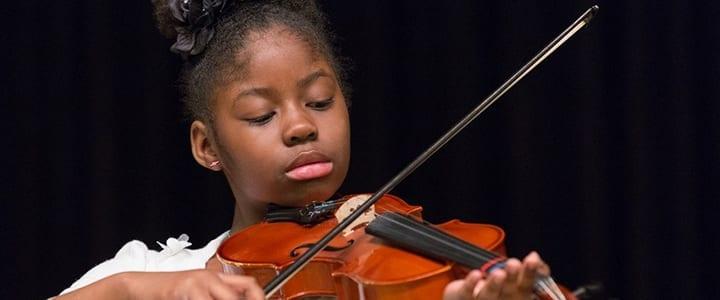Are you new to playing the violin? As a beginner, it’s important to create a strong foundation of which you can work off. Below, violin teacher Montserrat P. shares five violin basics every beginner should master…
Congratulations! You’ve been introduced to the wonderful art of music through one of the most beautiful instruments, the violin. As you continue to discover this wonderful instrument, it’s important to slowly build your skill set.
After all, learning to play the violin can be intimidating at first, and you don’t want to get overwhelmed by learning too much too fast. Below are five basic violin techniques every beginner should master before moving onto more complex techniques.
Double Stops
The string family can do something that not many other instruments can: play two notes at the same time. Composers take advantage of this special quality very often, which is why it’s so important that you work on it from the early stages of your musical development. To master the double stop technique, start by playing only the lower pitch. This will help your left-hand muscles memorize exactly where the note is, giving you the basics to build the rest of the chord.
Once you’ve settle your lower note, repeat the process with the upper pitch. When your left-hand has learned all of the notes, start playing them together. At this stage, pay special attention to the bow. Is the hair touching both strings? Can you hear both notes with the same level of clarity? One last piece of advice: be patient. Double stops are a major part of violin playing, and they require continual practice and hard work.
Left-Hand Articulation
Articulation is the clarity of sound with which you define each note. While a lot of it is generated using your right hand (i.e. bow hand), your left hand also plays an important role. Left-hand articulation will be particularly useful at moments when you’re playing several notes under a single stroke, like runs or grace notes. Here, you can’t use your bow to clarify the beginning of every note; therefore you use your left hand to make sure each one is clear and defined.
To develop this skill, you need to get into percussionist mode. Your fingertips will become your sticks, and the fingerboard will become your drum. Start with your index finger by moving it from the base, rather than from the tip. Make sure you can hear a percussive sound when your finger hits the wood. When you’re done with your first finger, move on to the next one, and repeat the process until you have practiced articulating with every finger.
Be careful. If you overdo this, you’ll not only diminish the quality of your sound, you’ll also jeopardize your muscles. An injured musician is an unhappy musician; so take care of yourself!
Trills
If you haven’t listened to Kreutzer’s Etude No. 19, you should do it before you read this. All my advice on this technique will be more useful if you’re familiar with trills beforehand. Trills are ornaments to a note that consist of playing the pitch above the base by moving your finger up and down as quickly and precisely as you can. What’s complicated about trills is getting a full, in-tune sound in such little time.
So, how do you do this? Let me introduce you to the metronome. Start by turning it to a slow tempo (60 bpm is a good starting point). Begin by playing two notes per beat, making sure you’re moving your finger from its base, just like you did when practicing left-hand articulation. Once you have mastered two notes per beat, move to three, then four, and so on, until your rhythm becomes an ornament.
You don’t have to go through all of these steps in one practice session. Perhaps one week you do only two notes per beat; then the next week you move up to three and four. The most important thing with trills is to take it at a pace that will allow you to be consistent.
Vibrato
Vibrato and trills are cousins, the only difference being that vibrato uses one finger and plays with a little more speed. When you vibrate, you’re letting the one finger you’re playing with move back and forth from what we will call the base contact point ( i.e. the place in the fingerboard where you place your finger to play a specific note).
The trick to getting a nice vibrato is to control the speed in which you vibrate. To do this, first identify where your vibrato is coming from. Is it the elbow, the wrist, or the knuckle? Once you have figured that out, you will then turn to your metronome. Just like you did with trills, start by slowly playing two notes per beat, then three, then four, and so on and so forth, making sure that you’re playing your base note and the note below it.
Also, practice vibrato at different speeds. During your musical development, you will come across many different pieces that will require you to vibrate slower or faster to achieve the character and texture the composer wants. Don’t focus on only one speed vibrato; rather, train your hand to vibrate at any pace, so that you’re ready when a song requires a slow, fast, or middle-speed vibrato.
Spiccato
Even though this is a slightly more advanced technique that you probably won’t use for a while, if you master it now, you will be way ahead of the game when it comes to standard repertoire.
When you do a spiccato stroke, your bow should be jumping from the strings pushed by your right-hand articulation. By pressing down with your right index finger, your bow will then go up and off the string, then come back down and repeat the process. The two most important things about your spiccato are your right-hand fingers and the direction of your bow.
When practicing this stroke, make sure to start by getting your bow-hand knuckles loose. Moving the smaller parts of the fingers will allow you to have a better control over your bow once it starts jumping off the strings. Also, be very aware of the direction of your bow. The hair is supposed to be moving parallel to the bridge, rather than back and forth between your face and your left hand.
One extra bit of advice…
Violin requires a lot of effort and time; that little piece of wood is going to be one of your worst enemies at times. All those hours you spend in the practice room fighting with your instrument over one passage will be worth it when you get on stage and perform for your audience, whether it is a 200-person theater or your seven-year-old cousin.
Just remember what made you want to start taking violin lessons in first place; think about where you want to go, and relish the precious moments music will give you. Now go get your music, your metronome, and your violin, and start practicing!
Montserrat P. teaches violin and music theory lessons with TakeLessons. Originally from Costa Rica, she is now completing her studies at Interlochen Arts Academy in Michigan. She is bilingual in English and Spanish, and has been teaching music lessons since 2012. Learn more about Montserrat here!
 Photo by Philadelphia Youth Orchestra
Photo by Philadelphia Youth Orchestra
Suzy S.


